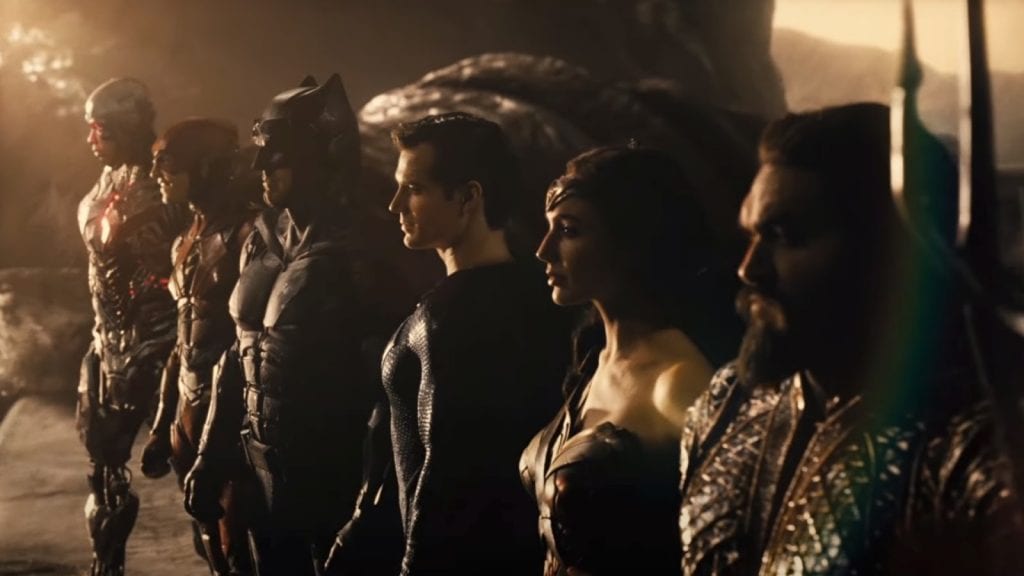Gods Among Us (Review: Zack Snyder’s Justice League)
Zack Snyder’s Justice League is streaming on HBO Max
Second chances don’t come around too often. That’s just as true in the movie business as it is anywhere else.* For filmmaker Zack Snyder, his 2017 film Justice League seemed to be firmly in the rear view mirror. Can you blame him?
The Marvel Cinematic Universe had producer Kevin Feige coordinating everything. The MCU made money — lots of it. Warner Bros. very quickly realized that a) they owned the rights to the DC comics characters and b) they also loved money. In short order, they rushed to create the competing DC Extended Universe. They didn’t have a Kevin Feige, however. Whether or not he wanted it, Zack Snyder set the tone of the DCEU with 2013’s Man of Steel. Snyder sprinted away from the affable charm and increasing foolishness of Christopher Reeve’s Superman films. Snyder envisioned his Kryptonian refugee as an earthbound god who was not entirely comfortable with his role as a hero.

Man of Steel wasn’t bad. It made around $668 million, which wasn’t MCU money but wasn’t a disappointment. Snyder moved on to Batman v. Superman: Dawn of Justice in 2016. The good news was that he wisely cast Ben Affleck as a bone-tired Dark Knight, and the film has a Batman action scene that easily blows away any others put to screen. The bad news, and there was quite a lot of bad news, was that BvS was a critical failure and under performed commercially. I remember getting bent out of shape that the film was wildly overstuffed, poorly written, and far too dark. Worst of all, it fundamentally didn’t understand the character of Superman. The talented and witty Henry Cavil played a Man of Steel who was a mopey jerk, one who couldn’t be bothered to crack a smile.
Warner Bros. executives were already having issues with the increasingly grimdark tone of the DCEU. Along with the disappointment of BvS, they cringed at the high-octane nonsense of Suicide Squad. Things were looking up with 2017’s Wonder Woman, but the suits were firm. Superhero movies needed to be lighter, funnier, more like the MCU. There needed to be a course correction.
During 2016, Zack Snyder was plugging away with the filming of Justice League. The plan was to compete with the MCU and to bring in the crowds and their money. They would assemble the world’s greatest superheroes, and audiences would thrill to see Superman, Batman, Wonder Woman, Cyborg, The Flash, and Aquaman locked in mortal combat with the iconic villain…um, Steppenwolf. Snyder was no fool, and he was as aware of the complaints regarding the darkness of BvS as anyone else. He strove to make the tone of Justice League lighter and funnier. The suits weren’t impressed.
Then, things got complicated. The word was that Warner Bros. hired Joss Whedon, one of the MCU’s architects, to handle massive rewrites and assist Snyder with re-shoots. An edict came down that the final cut of Justice League could not exceed two hours. As a result, the film had to be ruthlessly edited.
The cruelest blow came with the tragic suicide of Snyder’s daughter Autumn. He did what anybody would have done, what I absolutely would have done. He walked away from Justice League to work on healing his family and himself. Once Snyder left, Whedon essentially remade the film and, from all accounts, did so while creating a toxic work environment. He dragged a Frankensteined version of Justice League across the finish line, and presented executives with a movie that most critics hated and that most audience members didn’t care about.**
Time passed. Rumors spread of a Snyder Cut of Justice League, a cut that was longer, darker, and faithful to Snyder’s original vision. An online campaign gained steam, pressuring Warner Bros. to release it. Like all movements, some people involved were obnoxiously awful. The majority were not,*** and they pointed out that there was a precedent for this sort of thing, considering the studio had released Richard Donner’s previously unseen cut of Superman II.
The studio resisted. For a while. Zack Snyder mentioned that, while he hadn’t seen the theatrical cut, he did have a director’s cut. With some work, it could be completed. A meeting took place, and executives from Warner Bros. and HBO Max viewed the footage. They saw potential. After legal wrangling took place and more than $70 million was spent, Zack Snyder’s Justice League was completed. If you were so inclined, you could watch something that many considered to be a pipe dream in the comfort of your own home.
The Snyder Cut is now a reality. Is it any good, though?

The first thing you need to contend with is the inescapable fact that ZSJL is four hours and two minutes long. That’s not a hilarious joke or Trumpian exaggeration. There are thousands of new effects shots, a totally new score and soundtrack, the return of formerly cut scenes, and even some fully reshot scenes. Jared Leto appears briefly as The Joker. Jesse Eisenberg returns as Lex Luthor. DC’s legendary big bad Darkseid does some stuff. It literally takes about two hours before The Flash, Aquaman, and Cyborg stand in the same room together. The kitchen sink even shows up! You might think it’s all indulgent and all unnecessary. You might be right, except for one thing.
Zack Snyder, whether you like his aesthetic or not, is an auteur.
There’s a vast difference between a director and an auteur. Robert Schwentke, the filmmaker of R.I.P.D. and The Divergent Series: Allegiant is a director. Nothing against the guy, but if you watch Schwentke’s filmography, from the casting to the filmmaking style to the themes explored, you couldn’t reasonably claim that he has a distinctive point of view or that recurring thematic threads run through his work.
Martin Scorsese, who knows a thing or two about auteur theory and film, was asked about Marvel movies. He wrote in The New York Times that, “I’ve tried to watch a few of them and that they’re not for me, that they seem to me to be closer to theme parks than they are to movies as I’ve known and loved them throughout my life, and that in the end, I don’t think they’re cinema.” For Scorsese, cinema confronts the unexpected, and it does so through a fusion of skill and emotion. The auteur grapples with those questions and frequently returns to themes throughout their career. Scorsese is fascinated with Catholicism. Tarantino is obsessed with pop culture and its effects. Every auteur has a thing.
From Dawn of the Dead to 300 to Watchmen and very obviously Man of Steel, Snyder has been interested in power. Who has it? Who doesn’t? How do people react to it? There are aspects of that in ZSJL, but more so there’s a deep river of grief. Amy Adams’ Lois Lane grieves for her departed Clark. Victor Stone grieves for his humanity. It all comes back to Snyder grieving for his lost daughter. He seems to have remade his film as a tribute to their relationship and her legacy. That tribute is deeply emotional. It’s also deeply loud and frequently silly.
The end result is operatic in scope, including the overt, overly grandiose mortar that fills in the cracks. Snyder makes the comparison between the DCEU and the MCU distinct. Marvel’s heroes are frequently flawed, and the neurosis of Peter Parker or the alcoholism of Tony Stark shows that they’re just like the people they save. DC’s pantheon are cut from a different cloth, and they always have been. Snyder can be a good fit with that, as he likes to lean into the concept that DC’s heroes are gods walking the earth.
Let’s talk about that grandiose mortar. Here, the EXTREME knob is cranked all the way up to 11. Superman’s heat vision is now FIERY BEAMS OF DEATH! Batman drops an f-bomb! Steppenwolf has armor made from thousands of razors! Wonder Woman doesn’t just take out a terrorist, she obliterates the side of a building. Even when a janitor is mopping, his mop hits the ground with an echoing THWAP. Look, I am one hundred percent okay with a filmmaker making a choice because it’s awesome. The Matrix is one of the coolest things I have ever seen. The Wachowskis knew when to pump the brakes. In comparison, Snyder piles cinderblocks on the gas. To his credit, Snyder can direct gigantic action while still making it easy to follow and coherent, unlike certain people named Michael Bay I could mention. Yet when everything in the movie is massive, it becomes far more difficult for a moment to have an impact.
Having said that, ZSJL does an honest to Martha good job at character development. All the major characters have complete arcs. They change, grow, and are fundamentally different people at the end than they were at the beginning. The screenplay, which was a collaborative effort by Snyder, Chris Terrio, and Will Beall, takes the time to let us get to know everyone. Even the film’s antagonist, the unfortunate Steppenwolf, is portrayed as a bitter middle-management type. He’s conquered scores of worlds and it’s not nearly enough to get him back into the good graces of his boss, Darkseid. Steppenwolf isn’t a compelling villain on the level of a Darth Vader or Thanos. Now he has a point of view, which is a definite improvement.
There are significant improvements with the performances, as well, Ray Fisher’s Cyborg, who was shoved to the background in the theatrical version, is now the wounded heart of the film. He’s reckoning with what he views as a deformity, a place as a hero, and a lifetime of neglect from his father. While Fisher’s performance is still relatively low-key, there’s enough space for his performance to be appreciated. Ezra Miller’s Flash is funnier, as is Jason Momoa’s Aquaman. Gal Gadot is a more powerful and interesting Wonder Woman than in the majority of Wonder Woman 1984. Even Ben Affleck, who seemed checked out in the theatrical cut, is a more focused and interesting Batman. Henry Cavill is a little more muted as Superman. I remain thankful that he’s not playing the full grumpasaurus that appeared in BvS.
The Snyder Cut is a reality. Is it any good? Should you see it? It’s not an easy question to answer, because Zack Snyder’s Justice League isn’t a normal movie with a normal release date. It carries the stench of a botched previous version, the hopes of fans, and the shadow of a shattering tragedy. By any metric, it is a far better film than the theatrical release. While I don’t think it’s my cup of tea, I can see myself returning to it and appreciating the striking imagery and character work. Most importantly is that Zack Snyder has the opportunity to get a second chance and make a film that fulfills his vision. I have issues with that vision, yet I’m so happy that it exists.

*Or unless you’re a straight, white dude. Then second chances come around four, five, or six times!
**I gave the theatrical cut of Justice League a mostly positive review, and you know what? I was mostly wrong. It hit me differently after watching it again recently, and while I still like Cavill’s sunny performance as Superman, the film feels like the result of a committee instead of a vision. Our opinions change with time, and when I get something wrong, all I can do is be honest with you about it.
***Not for nothing, but it bears mentioning that an awful lot of fans of the Snyder Cut raised enormous amounts of money for the American Foundation for Suicide Prevention.


